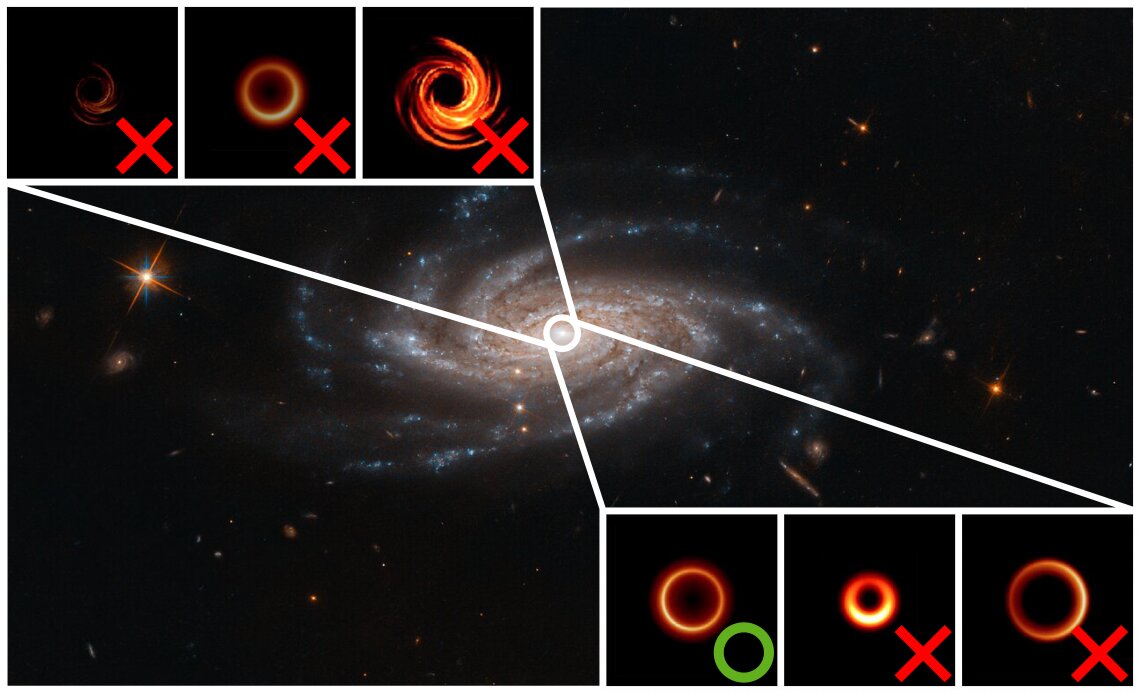As totally different as they might appear, black holes and Las Vegas have one factor in widespread: What occurs there stays there—a lot to the frustration of astrophysicists making an attempt to know how, when and why black holes kind and develop.
Black holes are surrounded by a mysterious, invisible layer—the event horizon—from which nothing can escape, be it matter, mild or info. The event horizon swallows each little bit of proof in regards to the black hole’s previous.
“Due to these bodily info, it had been thought inconceivable to measure how black holes fashioned,” mentioned Peter Behroozi, an affiliate professor on the College of Arizona Steward Observatory and a venture researcher on the Nationwide Astronomical Observatory of Japan.
Along with Haowen Zhang, a doctoral pupil at Steward, Behroozi led a world workforce to make use of machine learning and supercomputers to reconstruct the expansion histories of black holes, successfully peeling again their occasion horizons to disclose what lies past.
Simulations of hundreds of thousands of computer-generated “universes” revealed that supermassive black holes develop in lockstep with their host galaxies. This had been suspected for 20 years, however scientists had not been capable of affirm this relationship till now. A paper with the workforce’s findings has been printed in Month-to-month Notices of the Royal Astronomical Society.
“When you return to earlier and earlier instances within the universe, you discover that precisely the identical relationship was current,” mentioned Behroozi, a co-author on the paper. “So, because the galaxy grows from small to giant, its black hole, too, is rising from small to giant, in precisely the identical method as we see in galaxies right now all throughout the universe.”
Most, if not all, galaxies scattered all through the cosmos are thought to harbor a supermassive black hole at their middle. These black holes pack lots higher than 100,000 instances that of the sun, with some boasting hundreds of thousands, even billions of solar lots. One in all astrophysics’ most vexing questions has been how these behemoths develop as quick they do, and the way they kind within the first place.
To search out solutions, Zhang, Behroozi and their colleagues created Trinity, a platform that makes use of a novel type of machine studying able to producing hundreds of thousands of various universes on a supercomputer, every of which obeys totally different bodily theories for a way galaxies ought to kind. The researchers constructed a framework during which computer systems suggest new guidelines for a way supermassive black holes develop over time.
They then used these guidelines to simulate the expansion of billions of black holes in a digital universe and “noticed” the digital universe to check whether or not it agreed with many years of precise observations of black holes throughout the true universe. After hundreds of thousands of proposed and rejected rule units, the computer systems settled on guidelines that greatest described current observations.
“We’re making an attempt to know the principles of how galaxies kind,” Behroozi mentioned. “In a nutshell, we make Trinity guess what the bodily legal guidelines could also be and allow them to go in a simulated universe and see how that universe seems. Does it look something like the true one or not?”
Based on the researchers, this strategy works equally properly for the rest inside the universe, not simply galaxies.
The venture’s title, Trinity, is in reference to its three foremost areas of examine: galaxies, their supermassive black holes and their dark matter halos—huge cocoons of dark matter which are invisible to direct measurements however whose existence is important to clarify the bodily traits of galaxies in every single place. In earlier research, the researchers used an earlier model of their framework, referred to as the UniverseMachine, to simulate hundreds of thousands of galaxies and their dark matter halos. The workforce found that galaxies rising of their dark matter halos observe a really particular relationship between the mass of the halo and the mass of the galaxy.
“In our new work, we added black holes to this relationship,” Behroozi mentioned, “after which requested how black holes might develop in these galaxies to breed all of the observations folks have made about them.”
“We’ve got excellent observations of black hole lots,” mentioned Zhang, the paper’s lead creator. “Nevertheless, these are largely restricted to the native universe. As you look farther away, it turns into more and more tough, and finally inconceivable, to precisely measure the relationships between the lots of black holes and their host galaxies. Due to that uncertainty, observations cannot straight inform us whether or not that relationship holds up all through the universe.”
Trinity permits astrophysicists to sidestep not solely that limitation, but additionally the event horizon info barrier for particular person black holes by stitching collectively info from hundreds of thousands of noticed black holes at totally different phases of their progress. Regardless that no particular person black hole’s historical past may very well be reconstructed, the researchers might measure the typical progress historical past of all black holes taken collectively.
“When you put black holes into the simulated galaxies and enter guidelines about how they develop, you’ll be able to examine the ensuing universe to all of the observations of precise black holes that we’ve,” Zhang mentioned. “We are able to then reconstruct how any black hole and galaxy within the universe regarded from right now again to the very starting of the cosmos.”
The simulations make clear one other puzzling phenomenon: Supermassive black holes—just like the one discovered within the middle of the Milky Way—grew most vigorously throughout their infancy, when the universe was only some billion years outdated, solely to decelerate dramatically in the course of the ensuing time, during the last 10 billion years or so.
“We have recognized for some time that galaxies have this unusual habits, the place they attain a peak of their charge of forming new stars, then it dwindles over time, after which, in a while, they cease forming stars altogether,” Behroozi mentioned. “Now, we have been capable of present that black holes do the identical: rising and shutting off on the similar instances as their host galaxies. This confirms a decades-old speculation about black hole progress in galaxies.”
Nevertheless, the consequence poses extra questions, he added. Black holes are a lot smaller than the galaxies during which they stay. If the Milky Way have been scaled all the way down to the scale of Earth, its supermassive black hole could be the scale of the interval on the finish of this sentence.
For the black hole to double in mass inside the similar timeframe because the bigger galaxy requires synchronization between gasoline flows at vastly totally different scales. How black holes conspire with galaxies to attain this steadiness is but to be understood.
“I believe the actually authentic factor about Trinity is that it supplies us with a option to discover out what sort of connections between black holes and galaxies are in line with all kinds of various datasets and observational strategies,” Zhang mentioned.
“The algorithm permits us to select exactly these relationships between dark matter halos, galaxies and black holes which are capable of reproduce all of the observations which were made. It mainly tells us, ‘OK, given all these information, we all know the connection between galaxies and black holes should appear to be this, reasonably than like that.’ And that strategy is extraordinarily highly effective.”
Extra info:
Haowen Zhang (张昊文) et al, Trinity I: self-consistently modelling the dark matter halo–galaxy–supermassive black hole connection from z = 0–10, Month-to-month Notices of the Royal Astronomical Society (2022). DOI: 10.1093/mnras/stac2633
Offered by
University of Arizona
Quotation:
Machine studying reveals how black holes develop (2022, December 15)
retrieved 15 December 2022
from https://phys.org/information/2022-12-machine-reveals-black-holes.html
This doc is topic to copyright. Other than any honest dealing for the aim of personal examine or analysis, no
half could also be reproduced with out the written permission. The content material is offered for info functions solely.





